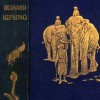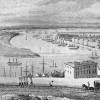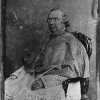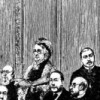
Carol Hanbery MacKay, “A Spiritual Materialist Turns Material Spiritualist: Annie Besant Rewrites Her Secularist Years, 1889 and 1891”
Examining the published texts of two lectures delivered by Annie Besant, “Why I Became a Theosophist” (4 and 11 August 1889) and “1875 to 1891: Fragment of Autobiography” (30 August 1891), this entry argues that they constitute a little-known bridge between her Secular and Theosophical years. Written during the interim between Besant’s only two full-length self-accountings, Autobiographical Sketches (1885) and An Autobiography (1893), the lectures provide the grounds for discovering her continuity as a spiritual materialist and a material spiritualist, thereby also bringing to the fore her effort to maintain an ongoing dialogue between science and religion.
![Figure 2: First Scottish colony for New Zealand. [Reprinted] Copyright People’s Palace Museum, Glasgow Green [ca 1981]. Alexander Turnbull Library, Wellington, New Zealand. Ref: Eph-C-IMMIGRATION-1839-01. Used with permission. http://natlib.govt.nz/records/22730739.](https://branchcollective.org/wp-content/uploads/2017/04/2-First-Scottish-Colony-for-New-Zealand-100x100.jpg)
Philip Steer, “On Systematic Colonization and the Culture of Settler Colonialism: Edward Gibbon Wakefield’s A Letter from Sydney (1829)”
In 1829, Edward Gibbon Wakefield published his first statement of a “systematic” theory of settler colonization, A Letter from Sydney: The Principal Town of Australasia. Wakefield offered a novel economic theory of the relationship between population density and successful colonization, hinging on the establishment of a minimum or “sufficient” price on colonial land, and he spent the next few decades at the forefront of efforts to promulgate and profit from it. The theory of systematic colonization was first put into practice in 1836 in the new colony of South Australia, and then more extensively in New Zealand in 1839; in both cases, speculative mania in Britain precipitated the invasion of thousands of settlers, even though the settlements were as yet unmapped. Wakefield’s theories were also at the center of a new imperial imaginary that emerged in Britain by the 1850s, which established Australia and New Zealand as pastoral locations capable of restoring damaged British subjects. In spurring the vast expansion of migration to Australia and New Zealand, contributing to the genocide and dispossession of indigenous populations, and accelerating the destruction of local ecosystems, systematic colonization constitutes one of the most powerful and destructive examples of the ability of Victorian representations to permanently reshape the globe.

Philip Howell, “June 1859/December 1860: The Dog Show and the Dogs’ Home”
In 1862, the Victorian journalist John Hollingshead (1827-1904) noted the comparability and complementarity of the Dog Show and the Dogs’ Home, both recent innovations: the first true dog show was held in June 1859 and the Temporary Home for Lost and Starving Dogs (now the Battersea Dogs and Cats Home) was founded in December 1860. This article considers these innovations as key events in the culture and treatment of companion animals in Britain, and their contribution to the Victorian “invention” of the dog.

Mario Ortiz-Robles, “Animal Acts: 1822, 1835, 1849, 1850, 1854, 1876, 1900”
What does the history of animal rights have to tell us about Victorian Britain – and how do legislative gains, specifically Parliamentary Acts, appear when read in tandem with theatrical performances and literary depictions of animals? This article reads the former category alongside the latter two, paying particular attention to how artistic representations of animals, including Rudyard Kipling’s The Jungle Book, blur the lines between human and animal behavior. In doing so, it sheds light on how animals were figured as part of a racialized discourse, using Foucault’s notion of biopower to help frame the complex ways animal rights, and animalism, were portrayed in politics and culture.

Anna Vaninskaya, “Russian Nihilists and the Prehistory of Spy Fiction”
Although the rise of modern British spy fiction is usually dated to the Edwardian period, with the names of Kipling, Conrad and Buchan among the first to be mentioned, the genre owes its existence to a little-noted precursor in late Victorian popular literature: the Russian Nihilist romance. Many of the ideological and formal aspects of the genre can be traced back to the tales of police espionage, terrorist revolutionaries, and double agents that titillated audiences in the last decades of the nineteenth century. In the 1880s and 90s, the age-old literary figure of the spy underwent a number of transformations that would establish its new meanings for the new century.

Carolyn W. de la L. Oulton, “‘Coquetting amid incredible landscapes’: Women on the River and the Railway”
The opening of the first direct railway line from London to the Kent coast in 1862 challenged traditional dichotomies between town and country, and contributed to a growing nostalgia associated with the river. Fin-de-siècle writers used the apparent opposition between rail and river, city and country, to ask new questions about the place of women in a rapidly changing world; the transition to a new century further strained the traditional dichotomy between feminised pastoral and masculinised industrial, a tension reflected in the problematic portrayal of rail and water in the work of E. Nesbit.

Miriam Burstein, “The ‘Papal Aggression’ Controversy, 1850-52”
This article provides an overview of the political, religious, and cultural response to the restoration of the Roman Catholic hierarchy in England. The Vatican’s decision to go ahead with this bureaucratic change was misunderstood in England, with immediate and unexpected consequences. Protestants across a wide range of denominations reacted harshly to the announcement, with repercussions not only for Catholics, but also for the Oxford Movement in the Church of England itself.

Lara Kriegel, “On the Death—and Life—of Florence Nightingale, August 1910”
This essay examines the death, and the life, of Florence Nightingale, the great nursing heroine of the Crimean War. An eminent Victorian, Nightingale passed away at the ripe old age of ninety in 1910, at a time when Britain was witnessing great internal strife and facing looming international tension. By that moment, the Crimean War was a thing of the distant past. Even so, Nightingale’s death served as a national tonic. It allowed mourners to rekindle the myths of Nightingale’s lifetime that had unified a ravaged nation in the wake of the Crimean War. Nightingale’s most important reforming efforts, which included nursing education, army improvement, and sanitary reform, both in Britain and in India, would postdate the Crimean War. However, the image of a young Nightingale ministering to the troops in the Crimea would remain the dominant one, not just in her life, but at her death as well. As it assesses the death and life of Nightingale, this essay focuses on two moments of celebrity and mythmaking in the long career of the heroine: the making of her legend in the Crimea and its resurrection at her death. It follows earlier literature, both generated during the nineteenth century and written by those who study it, establishing Nightingale as the avatar of Victorian womanhood. Accordingly, it seeks to understand Nightingale’s passing as a belated death knell to the Victorian age.

Carol Senf, “‘The Fiddler of the Reels’: Hardy’s Reflection on the Past”
While Thomas Hardy was invited to submit something to a special number of Scribner’s Magazine that was published to celebrate the 1893 Chicago World’s Fair, the story he submitted, “The Fiddler of the Reels,” focuses on several characters whose lives are impacted by the Great Exhibition of 1851. The focus on the two world’s fairs might lead readers to believe that Hardy was an advocate of the kinds of scientific and technological progress that such spectacles tended to celebrate. However, Hardy’s story demonstrates the power of more primitive forces and actually undermines such an easy belief in progress. By ending with a character that clearly represents primal forces that are never suppressed, the story demonstrates that the power of the primitive past is never far from the surface and may emerge at any moment to triumph over the representatives of the present.

Patricia Rigg, “Gender and Politics in London School Board Elections: Augusta Webster, Helen Taylor, and a Decade of Electoral Battles”
Augusta Webster’s service on the third London School Board 1879-1882 was preceded by a campaign fraught with attempts to deter her from proceeding through the election process. Mentored in August of 1879 by Helen Taylor, the stepdaughter of John Stuart Mill, Webster successfully attained a seat on the Board despite a male consortium of Board members determined to exclude women from this form of public office. The intrigue against her unfolds in the press and in correspondence archived in the Mill Taylor Collection at the London School of Economics. These documents reveal attempts to make her step down as a candidate in order to allow the four men of the previous Board to continue as a consortium for the district of Chelsea. She was accused of selfish ambition, of costing the district money that would be wasted when her inevitable defeat came about, and of impeding the work that could only be done effectively by men. Her success in this election and in the election of 1885 did not mitigate similar problems when she ran for a seat on the Board for the third time in 1888. Women candidates for Board seats were fewer in number than male candidates, and, it is hinted in the press, she failed to retain her seat as a result of her determination to improve the education available to girls and the salaries of women teachers and teaching assistants.
